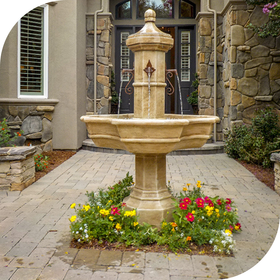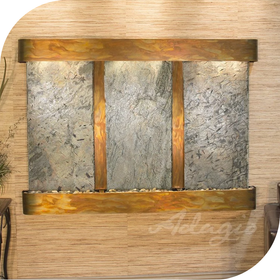Overview
Choosing the right materials for your garden fountain is crucial for its durability and visual appeal. Consider factors like climate, maintenance, and style when selecting materials such as concrete, stone, ceramic, metal, or solar options. Regular maintenance and strategic placement can enhance your fountain's longevity and overall garden aesthetic.
When it comes to adding a stunning water feature to your garden, selecting the right materials for your fountain is key to ensuring its longevity and aesthetic appeal. From bird baths to large garden fountains, the material choice can significantly impact the durability, maintenance, and overall look of your outdoor oasis. This guide covers various materials commonly used for fountains, helping you make an informed decision on your next exterior water feature.
Understanding the Importance of Fountain Materials
Fountain materials not only define the look of your water feature but also affect its resilience against environmental elements. Whether you’re looking to integrate a striking concrete fountain, a charming ceramic bird bath, or a modern solar water fountain, it's essential to understand how different materials withstand time and weather.
Factors to Consider When Choosing Fountain Materials
Before diving into the types of materials available, let’s consider some crucial factors that influence your decision:
-
Climate: Different materials react uniquely to heat, cold, and moisture.
-
Durability: You want a fountain that can withstand the test of time and elements.
-
Maintenance: Consider how much upkeep each material requires.
-
Style: The material should complement your landscaping and existing decor.
-
Weight: Heavier materials may be more stable but harder to move.
Popular Fountain Materials
Let’s explore some popular materials used for fountains, including bird bath fountains, garden fountains, and more, and understand their pros and cons.
Concrete
Concrete is a widely favored option for outdoor fountains and bird baths due to its robustness. Whether you’re looking at a concrete bird bath or a substantial garden fountain, here’s why concrete might be the right choice:
-
Durability: Concrete can withstand harsh weather conditions, making it ideal for varied climates.
-
Design Flexibility: Easily molded into a variety of shapes and sizes, concrete offers endless design possibilities.
-
Low Maintenance: While it might require sealing for longevity, overall upkeep is minimal.
Stone
The timeless beauty of a stone fountain brings a natural ambiance to any yard. Available in various types, appealing to different aesthetics, stone fountains are undoubtedly eye-catching.
-
Natural Appeal: Blends beautifully into garden settings with a rustic charm.
-
Longevity: Often resistant to wear and tear.
-
Heavyweight: Provides stability and won’t easily tip over.
Ceramic
If you’re looking for vibrant colors and intricate designs, a ceramic bird bath might be an ideal option. Here are some aspects to consider:
-
Aesthetic Variety: Available in various glazes and shapes, they can add a pop of color.
-
Lightweight: Easier to move than heavier materials, ideal for positioning flexibility.
-
Susceptibility to Damage: While beautiful, ceramics can chip or crack if not handled properly.
Metal
Metal fountains offer a distinctive look, often appreciated for their unique designs. However, they require careful consideration due to their reactions with different environmental factors.
-
Design Choices: Available in various finishes, metals can provide a modern or classic look.
-
Rust Resistance: Look for treated metal options; otherwise, rust can be an issue.
-
Weight and Placement: Generally lighter than stone but heavier than ceramic, metal fountains can still be moved with effort.
Solar-Powered Features
With the increasing popularity of solar power, many people are turning to solar bird bath fountains and solar water features for their eco-friendly benefits.
-
Energy Efficiency: Harnesses sunlight for operation, saving on energy costs.
-
Mobility: Typically lightweight and portable, making them easy to reposition.
-
Variety of Options: Available in various styles, from solar waterfall fountains to simple bird baths.
Maintaining Your Fountain
While choosing a sturdy material is important, maintenance is equally critical to extend the life of your fountain. Here are some maintenance tips for your outdoor fountains:
Regular Cleaning
Debris, algae, and minerals can accumulate in your bird bath or fountain, leading to unappealing appearances and inefficient operation. Clean your fountain regularly to keep it sparkling and working perfectly. Here’s how:
-
Use a Soft Brush: Gently scrub the surface to avoid scratches.
-
Check the Pump: Make sure that the pump functions efficiently to keep the water flowing.
-
Consider Water Quality: Use filtered water when possible to reduce mineral buildup.
Winter Preparations
Seasonal changes can take a toll on your fountain. Here are some additional steps to prevent winter damage:
-
Drain Your Fountain: Remove all water to prevent freezing and cracking.
-
Covering: Use a protective cover to shield it from harsh weather.
-
Disconnect the Pump: If you have a pump, ensure it doesn’t face freeze and damage.
Integrating Fountains Into Your Garden Pathway
When placing your fountain, think about how it complements your overall landscape. Strategically positioning a bird bath fountain can create a serene environment for both you and local wildlife.
Positioning Tips
-
Visibility: Place your fountain where it’s easily visible and easily accessed for maintenance.
-
Sunlight Consideration: Solar water fountains need ample sunlight for optimal performance, so avoid shaded areas.
-
Surrounding Plant Life: Consider how plants will look in combination with your fountain to enhance your yard’s appeal.
Enhancing Your Space with Additional Features
The beauty of a fountain can be further elevated when combined with other design elements, especially in a garden setting. Spend some time thinking about how to create a harmonious outdoor aesthetic.
Complementary Garden Additions
-
Pathways and Walkways: Design pathways that lead to your fountain, promoting exploration.
-
Lighting: Consider installing garden lights that illuminate your fountain at night, showcasing its beauty.
-
Seating Areas: Create cozy seating spots nearby where you can relax and enjoy the sound of flowing water.
Final Thoughts on Fountain Materials
The journey of selecting the right fountain materials for your space can be a rewarding endeavor. By considering the type of material that suits your aesthetic and practical needs, you can enjoy your outdoor centerpieces for years to come. From stunning garden water features to charming bird baths, ensuring the right selection will create a serene and welcoming atmosphere in your yard.
Explore your options thoughtfully and enjoy curating a space that not only highlights the beauty of nature but also serves as a retreat of peace and tranquility.






Leave a comment